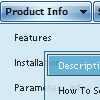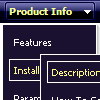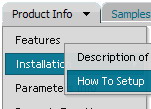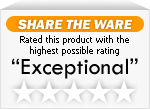Recent Questions
Q: I have changed the font parameters for the menu, but it only seems to affect the dropdown parts, the main menu font doesn't change, and I would like them to be consistent. How do I fix this?
A: Please, make sure that you don't use Individual Item Styles for themain items. If you're using styles you should change font in thisstyles.
Q: Then it is a bit annoying now that the menu bars in java does not work for
- Firefoxs
- Safari
For either Windows nor Mac.
According to your browser support this should work.
A: Links in your menu bars in java don't work in Firefox.
Now you have:
["Butiken","http://www.wexthuset.com/default.asp?sp_pid=8&sp_text=8"],
["|Tillbehцr","http://www.wexthuset.com/default.asp?ct=859&sp_pid=2&sp_page=1&sp_psort=22&
sp_sortfield=product_name&sp_sortorder=1&sp_pname=&sp_type=0&select_method=1"],
["||Belysning","http://www.wexthuset.com/default.asp?ct=859&sp_pid=2&sp_page=1&sp_psort=22&
sp_sortfield=product_name&sp_sortorder=1&sp_pname=&sp_type=5&select_method=1"],
["||Bevattning","http://www.wexthuset.com/default.asp?ct=859&sp_pid=2&sp_page=1&sp_psort=22&
sp_sortfield=product_name&sp_sortorder=1&sp_pname=&sp_type=11&select_method=1"],
....
try to write & instead of &.
["Butiken","http://www.wexthuset.com/default.asp?sp_pid=8&sp_text=8"],
["|Tillbehцr","http://www.wexthuset.com/default.asp?ct=859&sp_pid=2&sp_page=1&sp_psort=22&sp_sortfield=product_name&
sp_sortorder=1&sp_pname=&sp_type=0&select_method=1"],
["||Belysning","http://www.wexthuset.com/default.asp?ct=859&sp_pid=2&sp_page=1&sp_psort=22&sp_sortfield=product_name&
sp_sortorder=1&sp_pname=&sp_type=5&select_method=1"],
["||Bevattning","http://www.wexthuset.com/default.asp?ct=859&sp_pid=2&sp_page=1&sp_psort=22&sp_sortfield=product_name&
sp_sortorder=1&sp_pname=&sp_type=11&select_method=1"],
....
Q: I have built a new drop down css menu.
I have a named frame body but when I use the menu creater it works and changes the frame but when loaded to the site it says error on page.
what have I done wrong ?
Try the home which calls home_body.htm and about us which calls About Us.html in the body frame top the right of the menu.
A: You cannot use local paths on the Internet sites. They won't work.
["Home","", "", "", "", "", "", "", "", ],
["|Back to main page","D:/Web Design/CCA/home_body.htm", "", "", "", "", "body", "", "", ],
["About Us","", "", "", "", "", "", "", "", ],
["|History","D:/Web Design/CCA/About Us.html", "", "", "", "", "body", "", "", ],
You should write, for example:
["Home","", "", "", "", "", "", "", "", ],
["|Back to main page","home_body.htm", "", "", "", "", "body", "", "", ],
["About Us","", "", "", "", "", "", "", "", ],
["|History","About Us.html", "", "", "", "", "body", "", "", ],
Q: Can you please guide me how can i use the ajax functionality for tree view navigation..
A: To enable AJAX Tree Menu use the following menu parameters:
var tajax=1; // enables AJAX technology support
Each .js file must contain menuItems variable for the submenu in the following format:
var tmenuItems = [
[text, link, icon1, icon2, icon2, tip, target, itemStyle, submenuStyle, jsFileName],
];
Where jsFileName - .js filename on the server that contains tmenuItems variable for the submenu.
More info you'll find here:
http://deluxe-tree.com/ajax-menu-loading-sample.html









